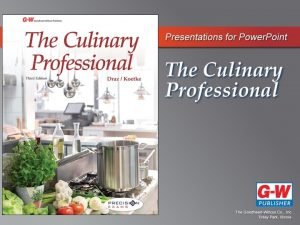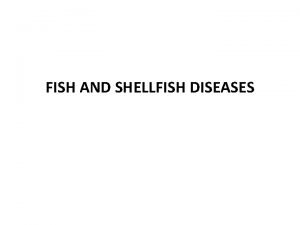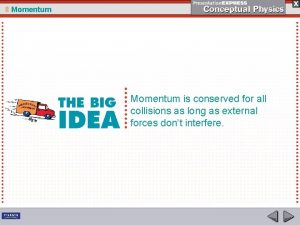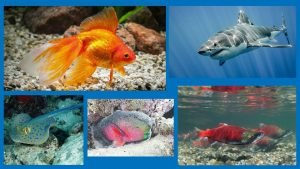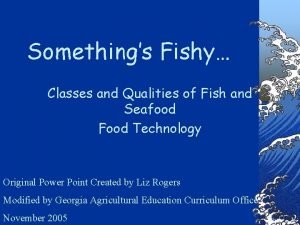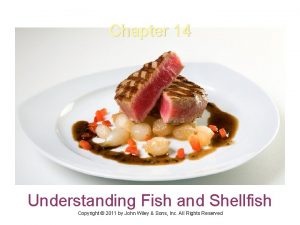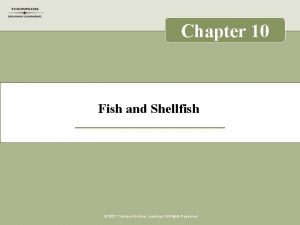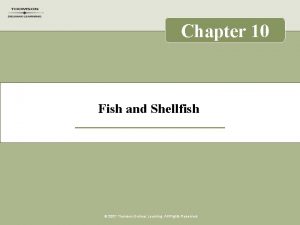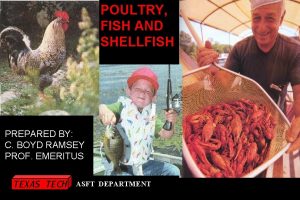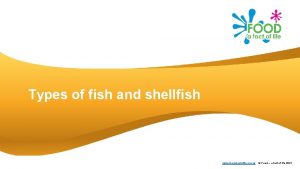Chapter 14 Understanding Fish and Shellfish Copyright 2011






























- Slides: 30

Chapter 14 Understanding Fish and Shellfish Copyright © 2011 by John Wiley & Sons, Inc. All Rights Reserved

Understanding Fish and Shellfish Fish products are divided into two categories: • Fin fish, or fish with fins and internal skeletons. • Shellfish, or fish with external shells but no internal bone structure. 2

Composition and Structure The edible flesh of fish consists of: • Water • Proteins • Fats • Small amounts of minerals, vitamins, and other substances 3

Composition and Structure Fish has very little connective tissue. • This means that: • Fish cooks very quickly. • Fish is naturally tender. • Moist-heat cooking methods are used not to create tenderness but to preserve moistness. • Cooked fish must be handled very carefully or it will fall apart. 4

Special Problems in Cooking Fish The major flaw in fish preparation is overcooking. • Observe these tests for doneness: 1. The fish just separates into flakes, or it is beginning to flake but does not yet fall apart easily. 2. If the bone is present, the flesh separates from the bone and the bone is no longer pink. 3. The flesh has turned from translucent to opaque (usually white, depending on the kind of fish). 5

Special Problems in Cooking Fish Cooking Fat Fish and Lean Fish The fat content of fish ranges from 0. 5% to 20%. • Lean fish are those that are low in fat. • Fat fish are those that are high in fat. 6

Special Problems in Cooking Fish Cooking Lean Fish Moist-heat method • Lean fish is especially well suited to poaching. • This method preserves moistness. Dry-heat method • Lean fish, if it is broiled or baked, should be basted with butter or oil. • Do not to overcook it, or the fish will be dry. Dry-heat method with fat • Lean fish may be fried or sautéed. • The fish gains palatability from the added fat. 7

Special Problems in Cooking Fish Cooking Fat Fish Moist-heat method • Fat fish, like lean fish, can be cooked by moist heat. Dry-heat method • Fat fish are well suited to broiling and baking. • The dry heat helps eliminate excessive oiliness. Dry-heat method with fat • May be cooked in fat. • Care should be taken to avoid excessive greasiness. 8

Cutting Fish Market Forms Whole or round: completely intact, as caught. Drawn: viscera removed. 9

Cutting Fish Market Forms Dressed: viscera, scales, head, tail and fins removed. Steaks: cross-section slices, each containing a section of backbone. 10

Cutting Fish Market Forms Fillets: boneless sides of fish, with skin on or off. Sticks or tranches: crosssection slices of fillets. 11

Cutting Fish Market Forms Butterflied Fillets: both sides of a fish still joined. 12

Cutting Fish Dressing a Fish Scale the Fish. Cut off the tail and fins. Scissors are easiest to use. Eviscerate. Slit the belly and pull out the viscera. Rinse the cavity. 13

Cutting Fish Dressing a Fish Remove the head. Cut through the flesh just behind gills. Cut or break the backbone at the cut and pull off the head. The fish is dressed. 14

Cutting Fish Filleting a Flatfish Use a thin-bladed, flexible knife. Cut off the head just behind the gills (this step is optional). Make a cut from head to tail, just to one side of the center line down to the backbone. 15

Cutting Fish Filleting a Flatfish Turn the knife so it is almost parallel to the table. Making long, smooth cuts, cut horizontally against the backbone toward the outer edge of the fish. Gently separate the fillet from the bone. Remove the fillet completely. 16

Cutting Fish Filleting a Round Fish Cut into the top of the fish along one side of the tail; detach the backbone from head to tail. Cut under the flesh toward the tail and detach the cut piece. 17

Cutting Fish Filleting a Round Fish Cut along the curved rib bones and finish detaching the fillet at the head. Turn the fish over and repeat to remove the second fillet. 18

Handling and Storage Checklist for Fish Freshness Overall appearance • Good appearance Clear slime • Moist and pliable fins Odor • Fresh and mild with no off-odors Eyes • Clear, shiny and bulging 19

Handling and Storage Checklist for Fish Freshness Gills • Red or pink Texture of flesh • Firm; elastic Scales • Shiny; tight on skin Belly cavity • No belly burn; natural-colored flesh, pink or red along backbone 20

Handling and Storage Storing Fresh Fish Objectives 1. To maintain temperature of 29° to 32°F (– 2° to 0°C). 2. To keep the fish moist. 3. To prevent fish odors and flavors from transferring to other foods. 4. To protect the delicate flesh from being bruised or crushed. 21

Handling and Storage Storing Fresh Fish Methods • On crushed ice (preferred method): • Use drip pans to allow for drainage of melted ice. • Change ice daily. • In refrigerated box at 29° to 32°F (– 2° to 0°C): • Use if crushed ice storage is not available or practical. • Wrap all fish or leave in original moisture proof wrap. 22

Handling and Storage Storing Fresh Fish Storage Time • Fresh fish may be stored for 1 or 2 days. If it must be kept longer, you may: 1. Wrap and freeze it immediately. 2. Cook and then refrigerate it for later use in recipes calling for cooked fish. 23

Handling and Storage Frozen, Canned, and Other Processed Fish Federal Inspection In the United States, voluntary inspections are conducted by: 1. The National Oceanic and Atmospheric Administration (NOAA). 2. The Department of Commerce. • Promotes the safety of processed fish and shellfish. 24

Handling and Storage Frozen, Canned, and Other Processed Fish Federal Inspection (cont’d) 3. Processors who wish to take part in the programs must pay for the service. 4. They may then use official seals or marks on their product packaging and in advertising. • PUFI seal (Processed Under Federal Inspection) • U. S. Grade A shield 25

Handling and Storage Frozen, Canned and Other Processed Fish Thawing and Handling • Frozen raw fish • Thaw in refrigerator. • Small pieces can be cooked from a frozen state. • Fillets, or other portions to be breaded or prepared in some other way before cooking, may be partially thawed. • Handle thawed fish as you would fresh fish. • Do not refreeze. 26

Shellfish Classification There are two classifications of shellfish: 1. Mollusks: Soft sea animals that fall into three main categories: • Bivalves, which have a pair of hinged shells (such as clams and oysters). • Univalves, which have a single shell (such as abalone and conch). • Cephalopods (such as octopus, squid and cuttlefish). 2. Crustaceans: Animals with segmented shells and jointed legs. 27

Shellfish Mollusks Oysters Mussels Clams Scallops 28

Shellfish Cephalapods Squid • Usually referred to on menus by their Italian name, calamari. Octopus • The name means “eight feet. ” 29

Shellfish Crustaceans Lobster Shrimp Crab 30
 One fish two fish red fish blue fish ride
One fish two fish red fish blue fish ride Shellfish identification
Shellfish identification Sticks fish market form
Sticks fish market form One fish two fish blowfish blue fish
One fish two fish blowfish blue fish Ammocoete
Ammocoete Fish and shellfish pathology
Fish and shellfish pathology How are fish and shellfish graded?
How are fish and shellfish graded? A big fish swims up and swallows a small fish at rest
A big fish swims up and swallows a small fish at rest Is croaker a cartilaginous fish
Is croaker a cartilaginous fish Fishbony
Fishbony Surgical prep guidelines
Surgical prep guidelines Classifications of shellfish
Classifications of shellfish Shellfish with a jointed exterior
Shellfish with a jointed exterior Market forms of fish drawn
Market forms of fish drawn National shellfish sanitation program
National shellfish sanitation program Qualities of shellfish
Qualities of shellfish Meat is firmest when it is cooked how well?
Meat is firmest when it is cooked how well? Servsafe definition
Servsafe definition Chapter 23 understanding income and taxes
Chapter 23 understanding income and taxes Understanding your health and wellness chapter 1
Understanding your health and wellness chapter 1 Understanding your health and wellness
Understanding your health and wellness Understanding your health and wellness
Understanding your health and wellness Lesson 4 promoting health and wellness
Lesson 4 promoting health and wellness Glencoe health chapter 1 understanding health and wellness
Glencoe health chapter 1 understanding health and wellness Chapter 1 lesson 2 what affects your health
Chapter 1 lesson 2 what affects your health Understanding your health and wellness chapter 1
Understanding your health and wellness chapter 1 Understanding health and wellness
Understanding health and wellness Understanding and comparing distributions
Understanding and comparing distributions Chapter 1 understanding health and wellness lesson 3
Chapter 1 understanding health and wellness lesson 3 Chapter 9 lesson 3 understanding violence
Chapter 9 lesson 3 understanding violence Understanding the scriptures chapter 24 study questions
Understanding the scriptures chapter 24 study questions

